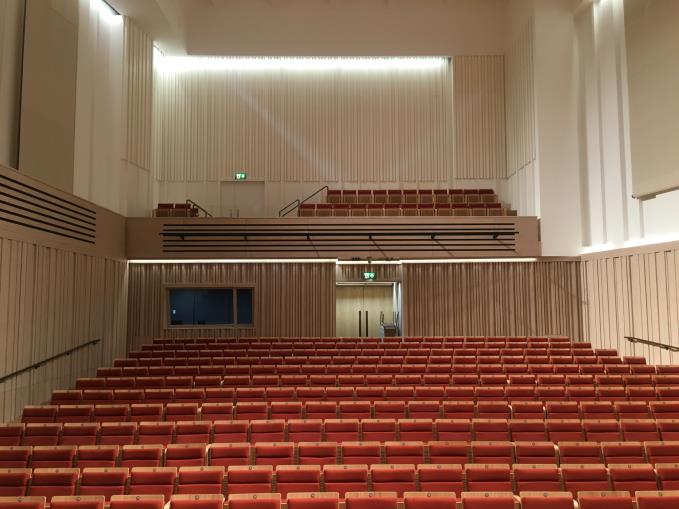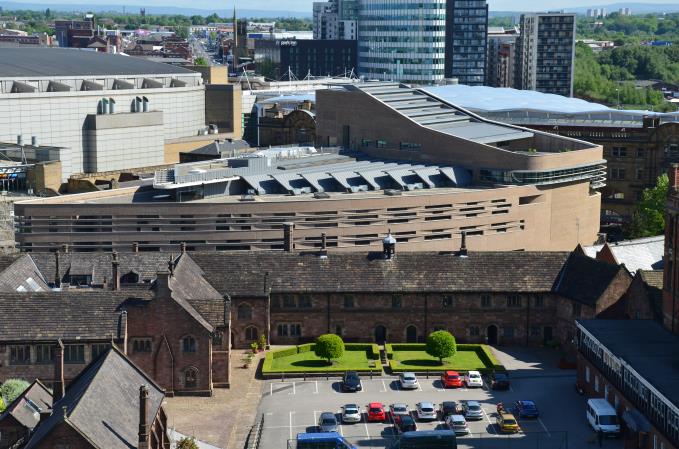TO BEGIN with the smell gets you just as much as the visuals. The bouquet is one of freshness and oak. Wholesome. Inspiring. There's an air of anticipation too, the pause before the action really starts. It's invigorating.
So when we open, I think we can say we will have the finest acoustic in the world - at least for a while
I’m in The Stoller Hall at Chetham’s School of Music with Richard Hartwell, the General Manager of the performance space. The hall will launch between April 21-23 next year following acoustic tests. There will be around 80 performance dates per year, including school performances, invited guest nights, masterclasses from former alumni and so on, plus hires for contemporary music as well as spoken word and comedy events.
“With the 482 seats we want to complement not compete with other similar scale venues across the city,” says Hartwell generously, a 31-year-old who studied at York University before gaining experience in the Royal Northern College of Music. He also spent time at The Barbican before returning to Manchester with Chetham’s.
The design of The Norman Stoller Hall comes from Manchester architect Roger Stephenson. The contractors were McAlpine and the accoustic engineers were from ARUP. The acoustic technology, complete with all manner of gadgets, including some particularly attractive drapery in the form of massive banners, is built to cope with a variety of uses.
“The fit-out and kit is literally up-to-the-minute. So when we open, I think we can say we will have the finest acoustic in the world - at least for a while," says Hartwell. "And one that can be manipulated for a single instrument or a full orchestra."
In its discipline and superb finish The Stoller Hall is a tribute to Stephenson’s overall concept for the new Chetham’s School building. It's a marvel of aesthetic and technical verve. Details such as the raking of the purpose built seats and how sound bounces back off them twist my mind but reveal the attention to detail.
 The view from the stage
The view from the stageWith the exception of the concert hall most of the £31m building opened in 2012 (click here). The concert hall remained unfinished which was just dandy for Manchester International Festival in 2013 who used the bare space to great effect for the acclaimed XX shows (reviewed here).
The delay in installing the concert hall might have been to everyone’s advantage.
“We conceived of the space while designing the overall building so we could make proper preparations for the inner box,” says Stephenson. “In some ways it may have been better that the two weren’t done at the same time and thus each element received our full attention.”
 The empty outer box in 2012
The empty outer box in 2012Stephenson goes on to describe the box within a box design, and how that sound-proofs the building but means the latest and silent air circulation techniques had to be included, also how the lighting rigs and stage combinations are all controlled by hand-held remotes. It begins to sound like science-fiction.
He continues, “We had to be careful with the oak interior, over time it would have faded to orange. So we applied a very thin white oil onto it, making it blonder. This should keep it looking fresh. In the end I’m happy we have delivered a space that, while an unusual size, should provide a very intimate experience. When I heard the Steinway being played I felt we’d cracked the brief which was to provide Chetham’s with an acoustically world-class music space.”
 The Steinway - waiting to rock the room
The Steinway - waiting to rock the roomA last point and one underlining the philanthropy of Sir Norman Stoller, the Oldham businessman famed for his association with Seton Healthcare, now SSL International, and the company behind the tubular bandage. This generous benefactor has donated £7.5m to the £8.7m price of the auditorium, hence the name of the new space. Stoller, along with fellow philanthropists such as Michael Oglesby and Carole Nash (who have both contributed to Chetham's), has been a boon to the music and arts of Manchester. We need as much philanthropy as we can get in these straitened times.
What is particularly sweet about the money the latter-day philanthropists have put into Chetham’s is that the institution began with philanthropy. The older part of the Chetham's complex was abandoned after the English Civil Wars. The already two hundred year-old buildings were brought back to life by the merchant Humphrey Chetham through his will in the 1650s.
He created a library and a school for poor boys with monies worth a shade short of £10,000 - a huge sum then. Chetham’s Library survives as it was created, the school has morphed into a centre of musical excellence for 8-18 year-olds. ‘Quod tuum tene’ was Humphrey Chetham’s motto. It means ‘hold onto what you’ve got’. As Chetham and Stoller both reveal, it’s better if you share.
 New and old buildings at Chetham's
New and old buildings at Chetham's













